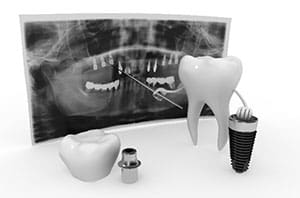Restorative Dentistry Services in Toledo
Dental Office in Sylvania

Restorative dentistry services repair, rebuild or replace teeth when something goes awry. Although the primary goal of restorative dentistry is to help the teeth and mouth function properly, these services also help improve the look of a smile.
If you have one or more broken, decayed or missing teeth, our team will work hard to treat these issues. We will lay out the available options and help you decide how best to proceed.
CEREC Same-Day Restorations
The CEREC system has changed the way our practice treats broken or missing teeth. Traditionally, if you wanted a crown, you would need to schedule two dental visits and wait for your restoration to be constructed off-site at a dental laboratory. Thanks to CEREC technology, we can design, construct and place your restoration in a single appointment, completing every step in-house. The restorations are just as strong and beautiful as lab-created restorations, but they can be completed much quicker.
Dental Implants
Dental implants are a great way to replace missing teeth. Unlike bridges, which attach to the adjacent teeth, or dentures, which rest on the gums, implants are anchored in the jawbone. As you can imagine, they are very strong and stable. They also provide stimulation to the jawbone to prevent bone deterioration. The placement process for dental implants is slightly more involved than that of other dental restorations, but the results can last a lifetime.
Full Mouth Reconstruction

Full mouth reconstruction is the process of rebuilding or replacing all of the teeth in the upper and lower jaw. The goal is to completely restore your ability to eat, speak and smile confidently. Our dentists do this by combining different restorative dentistry treatments. Every full mouth reconstruction is different, and yours will be tailored to your individual dental needs. Depending on the circumstances of your case, your full mouth reconstruction could include the placement of dental crowns, implants and/or bridges and possibly adjunct treatments such as orthodontic or periodontal treatment.
Minimally Invasive Restorative Dentistry
Our team believes in using the least invasive treatment methods whenever possible. For example, we never replace more natural tooth structure than is absolutely necessary, because we know that preserving as much natural tooth as possible is best for its long-term health and stability. Another example is using inlays or onlays instead of traditional fillings (whenever appropriate) to help conserve more natural tooth structure.
We try to incorporate this set of values into other areas of our practice. For instance, we may recommend teeth whitening to improve the look of dull (but structurally sound) teeth instead of placing restorations like veneers or crowns. And, we use dental lasers instead of dental drills to remove decay and bacteria from the teeth and gums.
Candidates for Restorative Dentistry

Restorative dentistry procedures are appropriate when you have decaying or infected teeth, teeth that are cracked or broken, or teeth that are missing altogether. They are the best solutions for recreating a complete smile and fully functional set of teeth. Following an examination, your dentist will address any of the existing problems in your mouth and make recommendations to improve your oral health.
Benefits of Restorative Dentistry
Restorative dentistry is popular because it:
- Protects the alignment of your teeth: missing teeth tend to shift out of place over time.
- Strengthens your bite and stops you from developing an irregular biting motion to compensate for a gap in your teeth.
- Makes it easier to speak normally since missing teeth can create speech impediments.
- Strengthens the jawbone, which can gradually weaken without stimulation from tooth roots.
- Boosts your confidence in your smile and your appearance.
Restorative Dentistry FAQs
When should I consider restorative dental procedures?
Dental restorations are necessary when oral health problems won’t improve with better dental hygiene or other treatments. The type and extent of your restorative dentistry procedures depends on the state of your teeth and gums and your medical history.

Generally, a dental restoration is needed when one or more teeth are compromised by tooth decay or injury, such as a missing tooth, cracked tooth, or tooth abscess (infection). Severe oral trauma can weaken a tooth and allow bacteria to grow into an infection and damage the tooth further, damaging the tooth enamel and dentin and may even reach the root. Damaged gums and teeth require dental restorations to improve functionality, but they also increase comfort and provide a more pleasing smile.
You may need restorative dentistry if you experience pain when you eat or chew or are severely sensitive to hot and cold temperatures long after you’ve finished the food or beverage.
What are dental crowns, and why are they used?
Crowns are dental restorations that cover an existing tooth structure. These “caps” protect and strengthen a damaged or decayed tooth to avoid tooth extraction and improve its appearance. Our restorative dentists use the CEREC system to fabricate a dental crown out of ceramic that matches the shape and shade of your adjacent teeth during your appointment.
Dental crowns can repair a broken tooth or cover a tooth when there is not enough natural tooth left after a large filling. These restorations also attach dental bridges to surrounding teeth and act as artificial teeth or “pontics” when one or more teeth are lost. Dental crowns attach to dental implants to replace a missing tooth.
When is root canal therapy needed, and what does it involve?
Root canal treatment removes infected pulp from the middle of a damaged tooth. Our dentists remove the inflamed pulp, clean the inside of the tooth and root canal, and fill them with gutta-percha, a thermoplastic material. The tooth is sealed shut to prevent more bacteria from entering the tooth root and canal.
Root canals can salvage a tooth and are often required when a tooth cracks or has severe tooth decay. Sometimes, a previous filling may allow bacteria into the tooth and require root canal treatment. Schedule a dental exam if you experience tooth sensitivity, severe mouth pain, swollen gums, or darkening gums. A pimple-like bump on the gums may indicate infection.
Can restorative dentistry improve the appearance of my teeth?

Restorative dentistry procedures focus on improving oral health by addressing issues with the teeth and gums. Sometimes, dental restorations offer cosmetic benefits, such as reconstructing a smile by filling in gaps from missing teeth with dental implants and fixing the alignment of crooked teeth surrounding tooth gaps. Dental crowns covering a damaged tooth match the surrounding teeth and improve the aesthetics of your teeth. While the goal of restorative dentistry doesn’t include cosmetic appeal, these imperfections are often addressed at the same time because a severely decayed or broken tooth affects your oral health and your smile appearance.
Is restorative dentistry covered by dental insurance?
Dental insurance plans typically cover a percentage of the expenses for preventive, basic, and major dental care services. While most insurance providers cover 100% of preventative care, they may only cover 50% of major dental restorations, including dental crowns or dental implants. Dental insurance plans typically have an annual maximum to pay toward your dental care, such as $2,000. Check with your dental insurance provider to determine what your plan covers for restorative dentistry.
How long do restorative dental procedures last?
The longevity of dental restorations depends on the type of restoration and how well you care for them. Most restorations don’t require special care, but you must brush twice daily and floss once daily. People with dental bridges may need special flossers and other steps to clean their bridges. Dental implants and crowns often last 15 years or longer, and fillings may last 20 years. Dental bonding may last three to 10 years.
What are my options for replacing a missing tooth/teeth?
Restorative dentistry offers a few different ways to complete your smile. A dental implant is the most popular because it surgically attaches a prosthetic tooth into your jawbone. Dental bridges are another great option; they typically connect to your natural teeth and hold the prosthetic in place to fill the gap. If you have many missing teeth, you may be a better candidate for dentures (or partial dentures). A variety of factors, including your budget, the health of your jawbone and other teeth, and the position of the missing teeth will help your dentist to recommend the best treatment for you.
Schedule an Appointment With Our Team Today
You deserve the comfort and confidence that comes from having a complete, healthy smile. To discuss your restorative dentistry options with our team, please contact Dental Health Associates today and request an appointment.


